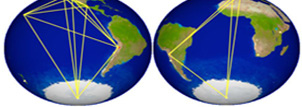Earth-Sized Telescope Expands to the South Pole to See Black Holes in Detail

TUCSON, Arizona – Astronomers building an Earth-size virtual telescope capable of photographing the event horizon of the black hole at the center of our Milky Way have extended their instrument to the bottom of the Earth — the South Pole — thanks to recent efforts by a team led by Dan Marrone of the University of Arizona.
[The four paragraphs quoted here are from a UA Press release written by Daniel Stolte. The link to the complete story can be found below.]
Marrone, an assistant professor in the UA's Department of Astronomy and Steward Observatory, and several colleagues flew to the National Science Foundation’s Amundsen-Scott South Pole Station in December to bring the South Pole Telescope, or SPT, into the largest virtual telescope ever built — the Event Horizon Telescope, or EHT. By combining telescopes across the Earth, the EHT will take the first detailed pictures of black holes.
The EHT is an array of radio telescopes connected using a technique known as Very Long Baseline Interferometry, or VLBI. Larger telescopes can make sharper observations, and interferometry allows multiple telescopes to act like a single telescope as large as the separation — or "baseline" — between them.
"Now that we’ve done VLBI with the SPT, the Event Horizon Telescope really does span the whole Earth, from the Submillimeter Telescope on Mount Graham in Arizona, to California, Hawaii, Chile, Mexico, Spain and the South Pole," Marrone said. "The baselines to SPT give us two to three times more resolution than our past arrays, which is absolutely crucial to the goals of the EHT. To verify the existence of an event horizon, the 'edge' of a black hole, and more generally to test Einstein's theory of general relativity, we need a very detailed picture of a black hole. With the full EHT, we should be able to do this."
This story and images are online at http://uanews.org/story/virtual-telescope-expands-to-see-black-holes.

For Public
Public events include our Monday Night Lecture Series, world-reknowned Astronomy Camp and Mt Lemmon Sky Center.

For Students
A good place to start if you want to become an undergrad major or grad student, or need to find our schedule of classes.

For Scientists
Find telescopes and instruments, telescope time applications, staff and mountain contacts, and faculty and staff scientific interests.




